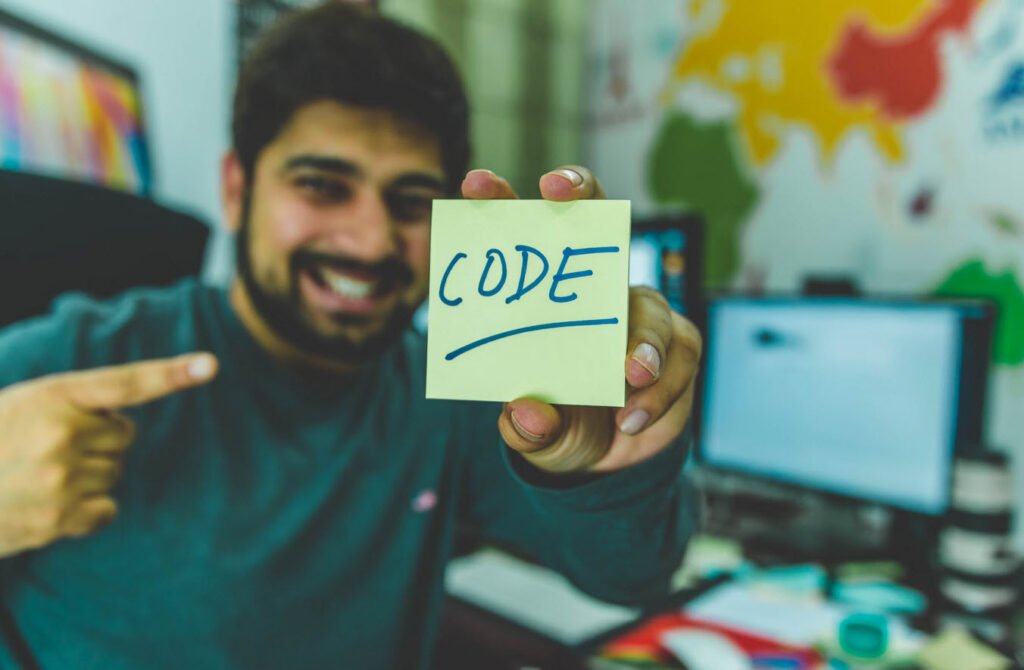
Python is a high-level, interpreted programming language known for its simplicity and readability. Created by Guido van Rossum in the late 1980s, Python has gained immense popularity among developers due to its versatility and extensive range of applications. Whether you are a beginner or an experienced programmer, Python offers a user-friendly and intuitive syntax that makes it easy to learn and use.
| abstraction | The purposeful hiding or ignoring of some details in order to concentrate on those that are relevant. |
| accessor method | A method that returns the value of one or more of an object’s instance variable(s), but does not modify the object. |
| accumulator pattern | A common programming pattern in which a final answer is built a piece at a time in a loop. |
| accumulator variable | A variable that is used to hold the result in the accumulator programming pattern. |
| actual parameter | A value that is passed to a function when it is called. |
| algorithm | A detailed sequence of steps for carrying out some process. |
| aliasing | The situation in which two or more variables refer to exactly the same object. If the object is mutable, then changes made through one variable will be seen by the others. |
| analysis | 1) In the context of the software development lifecycle, this refers to the process of studying a problem and figuring out what a computer program might do to solve it. 2) Studying a problem or algorithm mathematically to determine some of its properties, such as time efficiency. |
| and | A binary Boolean operator that returns true when both of its subexpressions are true. |
| application programming interface (API) | A specification of the functionality provided by a library module. A programmer needs to understand the API to be able to use a module. |
| argument | An actual parameter. |
| array | A collection of similar objects that can be accessed through indexing. Usually arrays are fixed-sized and homogeneous (all elements are of the same type). |
| ASCII | American Standard Code for Information Interchange. A standard for encoding text where each character is represented by a number 0-127. |
| assignment | The process of giving a value to a variable. |
| associative array | A collection where values are associated with keys. Called a dictionary in Python. |
| attributes | The instance variables and methods of an object. |
| base case | In a recursive function or definition, a situation in which recursion is not required. All proper recursions must have one or more base cases. |
| batch | A mode of processing in which input and output is done through files rather than interactively. |
| binary | The base-2 numbering system in which the only digits are 0 and 1. |
| binary search | A very efficient searching algorithm for finding items in a sorted collection. Requires time proportional to log2 n where n is the size of the collection. |
| bit | Binary digit. A fundamental unit of information. Usually represented using 0 and 1. |
| body | A generic term for the block of statements inside a control structure such as a loop or decision. |
| Boolean algebra | The rules that govern simplification and rewriting of Boolean expressions. |
| Boolean expression | A truth statement. A Boolean expression evaluates to either true or false. |
| Boolean operations | Connectives for constructing Boolean expressions. In Python, and, or, and not. |
| bug | An error in a program. |
| butterfly effect | A classic example of dynamical systems in nature (chaos). Supposedly, an event as small as the flapping of a butterfly’s wing can significantly influence subsequent large-scale weather patterns. |
| byte code | An intermediate form of computer language. High-level languages are sometimes compiled into byte code, which is then interpreted. In Python, files with a pyc extension are byte code. |
| call | The process of invoking a function’s definition. |
| central processing unit (CPU) | The ”brain” of the computer where numeric and logical operations are carried out. |
| cipher alphabet | The symbols that are used to encrypt a message. |
| ciphertext | The encrypted form of a message. |
| class | A class describes a set of related objects. The c lass mechanism in Python is used as a “factory” to produce objects. |
| client | In programming, a module that interfaces with another component is called a client for the component. |
| code injection | A form of computer attack in which a malicious user introduces computer instructions into an executing program, causing the application to deviate from its original design. |
| coding | The process of turning an algorithm into a computer program. |
| comment | Text placed in a program for the benefit of human readers. Comments are ignored by the computer. |
| compiler | A complex program that translates a program written in a high-level language into the machine language that can be executed by a particular computer. |
| computer | A machine that stores and manipulates information under the control of a changeable program. |
| computer science | The study of what can be computed. |
| conditional | Another term for a decision control structure. |
| constructor | A function that creates a new object. In a Python class, it is the __ ini t __ method. |
| control codes | Special characters that do not print, but are used in the interchange of information. |
| control structure | A programming language statement that controls the execution of other statements (e.g., if and while). |
| coordinate transformation | In graphical programming, the mathematics of changing a point or set of points from one coordinate system to a related one. |
| counted loop | A loop written to iterate a specific number of times. |
| cryptography | The study of techniques for encoding information to keep it secure. |
| data | The information that a computer program manipulates. |
| data type | A particular way of representing data. The data type of an item determines what values it can have and what operations it supports. |
| debugging | The process of finding and eliminating errors in a program. |
| decision structure | A control structure that allows different parts of a program to execute depending on the exact situation. Usually decisions are controlled by Boolean expressions. |
| decision tree | A complex decision structure in which an initial decision branches into more decisions, which branch into more decisions in a cascading fashion. |
| definite loop | A kind of loop where the number of iterations is known at the time the loop begins executing. |
| design | The process of developing a system that can solve some problem. Also the product of that process. |
| dictionary | An unordered Python collection object that allows values to be associated with arbitrary keys. |
| docstring | A documentation technique in Python that associates a string with a program component. |
| empty string | An object that has the data type string, but contains no characters (11 11). |
| encapsulation | Hiding the details of something. Usually this is the term used to describe the distinction between the implementation and use of an object or function. |
| encryption | The process of encoding information to keep it private. |
| end-of-file loop | A programming pattern used to read a file line by line. |
| event | In GUI programming, an outside action such a mouse click that causes something to happen in a program. Also used to describe the object that is created to encapsulate the information about the event. |
| event-driven | A style of programming in which the program waits for events to happen and responds accordingly. This approach is frequently used in graphical user interface (GUI) programming. |
| exception handling | A programming language mechanism that allows the programmer to gracefully deal with errors that are detected when a program is running. |
| execute | To run a program or segment of a program. |
| exponential time | An algorithm that requires a number of steps proportional to a function in which the problem size appears as an exponent. Such algorithms are generally considered intractable. |
| expression | A part of a program that produces data. |
| fetch-execute cycle | The process a computer carries out to execute a machine code program. |
| float | A data type for representing numbers with fractional values. Short for “floating point.” |
| flowchart | A graphical depiction of the flow of control in a program or algorithm. |
| function | A subprogram within a program. Functions take parameters as input and can return values. |
| garbage collection | A process carried out by dynamic programming languages (e.g., Python, Lisp, Java) in which memory locations that contain values that are no longer in use are freed up so that they can store new values. |
| graphical user interface (GUI) | A style of interaction with a computer application that involves heavy use of graphical components such as windows, menus, and buttons. |
| graphics window | An on-screen window where graphics can be drawn. |
| halting problem | A famous unsolvable problem. A program that determines if another program will halt on a given input. |
| hardware | The physical components of a computing system. If it goes “crash” when you toss it out the window, then it’s hardware. hash Another term for associative array or dictionary. |
| hello, world | The ubiquitous first computer program. |
| heterogeneous | Capable of containing more than a single data type at one time. Python lists, for example. |
| homogeneous | Capable of holding values of only a single type. |
| identifiers | The names that are given to program entities. |
| if statement | A control structure for implementing decisions in a program. |
| import statement | A statement that makes an external library module available for use within a program. |
| indefinite loop | A loop for which the number of iterations required is not necessarily known at the time the loop begins to execute. |
| indexing | Selecting a single item from a sequence based on its relative position in the sequence. |
| infinite loop | A loop that does not terminate. |
| inheritance | Defining a new class as a specialization of another class. |
| input, process, output | A common programming pattern. The program prompts for input, processes it, and outputs a response. |
| input validation | The process of checking the values supplied by a user to make sure that they are legitimate before performing a computation with those values. |
| instance | A particular object of some class. |
| instance variable | A piece of data stored inside an object. |
| int | A data type for representing numbers with no fractional component. Int is short for integer and represents a number with a fixed number of bits (commonly 32). |
| integer | A positive or negative whole number. |
| interactive loop | A loop that allows part of a program to repeat according to the wishes of the user. |
| interface | The connection between two components. For a function or method, the interface consists of the name of the function, its parameters and return values. For an object, it is the set of methods (and their interfaces) that are used to manipulate the object. The term user interface is used to describe how a person interacts with a computer application. |
| interpreter | A computer program that simulates the behavior of a computer that understands a high-level language. It executes the lines of source one by one and carries out the operations. |
| intractable | Too difficult to be solved in practice, usually because it would take too long. |
| invoke | To make use of a function. |
| iterate | To do multiple times. Each execution of a loop body is called an iteration. |
| key | 1) In encryption, a special value that must be known to either encode or decode a message. 2) In the context of data collections, a way to look up a value in a dictionary. Values are associated with keys for future access. |
| lexicographic | Having to do with string ordering. Lexicographic order is like alphabetical order, but based on the underlying numeric codes of the string’s characters. |
| library | An external collection of useful functions or classes that can be imported and used in a program. For example, the Python math and string modules. |
| linear search | A search process that examines items in a collection sequentially. |
| linear time algorithm | An algorithm that requires a number of steps proportional to the size of the input problem. |
| list | A general Python data type for representing sequential collections. Lists are heterogeneous and can grow and shrink as needed. Items are accessed through subscripting. |
| literal | A notation for writing a specific value in a programming language. For example, 3 is an int literal and “Hello” is a string literal. |
| local variable | A variable defined inside a function. It may only be referred to within the function definition. |
| log time algorithm | An algorithm that requires a number of steps proportional to the log of the size of the input problem. |
| loop and a half | A loop structure that has an exit somewhere in the midst of the loop body. In Python this is accomplished via a while True :/break combination. |
| loop | A control construct for executing portions of a program multiple times. |
| loop index | A variable that is used to control a loop. In the statement: f or 1. in range (n), i is being used as a loop index. |
| machine code | A program in machine language. |
| machine language | The low-level (binary) instructions that a given CPU can execute. |
| main memory | The place where all data and program instructions that the CPU is currently working on resides. Also known as random access memory (RAM). |
| mapping | A general association between keys and values. Python dictionaries implement a mapping. |
| merge | The process of combining two sorted lists into a single sorted list. |
| merge sort | An efficient divide-and-conquer sorting algorithm. |
| meta-language | A notation used to describe the syntax of a computer language. |
| method | A function that lives inside an object. Objects are manipulated by calling their methods. |
| mixed-typed expression | An expression involving more than one data type. Usually used in the context of combining ints and floats in numeric computations. |
| model-view architecture | Dividing up a GUI program by separating the problem (model) from the user interface (view). |
| modal | A window or dialog box is modal if it requires the user to interact with it in some way before continuing to use the application that generated it. |
| modular | Consisting of multiple, relatively independent pieces that work together. |
| module | Generally, any relatively independent part of a program. In Python, the term is also used to mean a file containing code that can be imported and executed. |
| module hierarchy chart | A diagram showing the functional decomposition structure of a program. A line between two components shows that the one above uses the one below to accomplish its task. |
| Monte Carlo | A simulation technique that involves probabilistic (random or pseudorandom) elements. |
| mutable | Changeable. An object whose state can be changed is said to be mutable. Python ints and strings are not mutable, but lists are. |
| mutator method | A method that changes the state of an object (i.e., modifies one or more of the instance variables). |
| n log n algorithm | An algorithm that requires a number of steps that is proportional to the size of the input times the log of the size of the input. |
| n-squared algorithm | An algorithm that requires a number of steps that is proportional to the square of the size of the input. |
| name error | An exception that occurs when Python is asked to produce a value for a variable that has not been assigned a value. |
| namespace | An association between identifiers and the things that they represent in a program. In Python, modules, classes, and objects act as namespaces. |
| nesting | The process of placing one control structure inside of another. Loops and decisions may be arbitrarily nested. |
| newline | A special character that marks the division between lines in a file or a multiline string. In Python, it is denoted “\n”. |
| not | A unary Boolean operator to negate an expression. |
| object | A program entity that has some data and a set of operations to manipulate that data. |
| object-based | Design and programming that uses objects as the principle form of abstraction. |
| object-oriented | Object-based design or programming that includes characteristics of polymorphism and inheritance. |
| open | The process of associating a file in secondary memory with a variable in a program through which the file can be manipulated. |
| operator | A function for combining expressions into more complex expressions. or A binary Boolean operator that returns true when either or both subexpressions are true. |
| override | The term applied to a situation when a subclass changes the behavior of an inherited method. |
| parameters | Special variables in a function that are initialized at the time of call with information passed from the caller. |
| pass by value | A parameter-passing technique used in Python. The formal parameters are assigned the values from the actual parameters. The function cannot change which object an actual parameter variable refers to. |
| pass by reference | A parameter-passing technique used in some computer languages that allows the value of a variable used as an actual parameter to be changed by the called function. |
| pixel | Short for picture element. A single dot on a graphical display. |
| plaintext | In encryption, this is the term used for an unencoded message. |
| polymorphism | Literally “many forms.” In object-oriented programming, the ability of a particular line of code to be implemented by different methods depending on the data type of the object involved. |
| portability | The ability to run a program unmodified on various different systems. |
| post-test loop | A loop construct where the loop condition is not tested until after the loop body has been executed. |
| pre-test loop | A loop construct where the loop condition is tested before executing the body of the loop. |
| precision | The number of digits of accuracy in a number. |
| priming read | In a sentinel loop, a read before the loop condition is tested. |
| private key | A kind of encryption where the same key is used to both encrypt and decrypt and must therefore be kept secret. |
| program | A detailed set of instructions for a computer to carry out. |
| programming | The process of creating a computer program to solve some problem. |
| programming environment | A special computer program that provides facilities to make programming easier. IDLE (in the standard Python distribution) is an example of a simple programming environment. |
| programming language | A notation for writing computer programs. Usually used to refer to high-level languages such as Python, Java, C++, etc. |
| prompt | A printed message that signals to the user of a program that input is expected. |
| prototype | An initial simplified version of a program. |
| pseudocode | A notation for writing algorithms using precise natural language, instead of a computer language. |
| pseudo-random | Sequences of numbers generated by computer algorithms and used to simulate random events. |
| public key | A form of encryption that uses two different keys. A message encoded with a public key can only be decoded using a separate private key. |
| random walk | A simulation process in which movement of some object is determined probabilistically. |
| read | A term used to describe computer input. A program is said to read information from the keyboard or a file. |
| record | A collection of information about a single individual or object. For example, a personnel record contains information about an employee. |
| recursive | Having a quality (for a function or definition) of referring to itself. |
| recursive function | A function that calls itself, either directly or indirectly. |
| relational operator | An operator that makes a comparison between values and returns true or false (e.g., <, <=, ==, >=, >, ! =). |
| reserved words | Identifiers that are part of the built-in syntax of a language. |
| resolution | The number of pixels on a graphics screen. Usually expressed as horizontal by vertical (e.g., 640×480). |
| RGB value | A representation of a color as three numbers (typically in the range 0-255) that represent the brightness of the red, green, and blue color components of a pixel. |
| scope | The area of a program where a given variable may be referenced. For example, variables defined in functions are said to have local scope. |
| script | Another name for a program. Usually used to refer to a relatively simple program written in an interpreted language. |
| search | The process of finding a particular item in a collection. |
| secondary memory | A generic term referring to nonvolatile storage devices such as hard disks, floppy disks, magentic tapes, CD-ROMs, DVDs, etc. |
| seed | The value used to start generation of a pseudorandom sequence. |
| selection sort | Ann-squared-time sorting algorithm. |
| self parameter | In Python, the first parameter of a method. It is a reference to the object to which the method is being applied. |
| semantics | The meaning of a construct. |
| sentinel | A special value used to signal the end of a series of inputs. |
| sentinel loop | A loop that continues until a special value is encountered. |
| short-circuit evaluation | An evaluation process that returns an answer as soon as the result is known, without necessarily evaluating all of its subexpressions. In the expression (True or is over()) the is over() function will not be called. |
| signature | Another term for the interface of a function. The signature includes the name, parameter(s), and return value(s). |
| simulation | A program designed to abstractly mimic some real-world process. |
| simultaneous assignment | A statement that allows multiple variables to be assigned in a single step. For example, x, y = y, x swaps two variables. |
| slicing | Extracting a subsequence of a string, list, or other sequence object. |
| software | Computer programs. |
| sorting | The process of arranging a sequence of items into a pre-determined ordering. |
| source code | The text of a program in a high-level language. |
| spiral design | Creating a system by first designing a simplified prototype and then gradually adding features. |
| statement | A single command in a programming language. |
| step-wise refinement | The process of designing a system by starting with a very highlevel, abstract description and gradually adding in details. |
| string | A data type for representing a sequence of characters (text). |
| subclass | When one class inherits from another, the inheriting class is called a subclass of the class from which it inherits. |
| substring | A sequence of contiguous characters inside a string. |
| superclass | A class which is being inherited from. |
| syntax | The form of a language. |
| tkinter | The Standard GUI framework that comes with Python. |
| top-down design | The process of building a system by starting with a very high-level algorithm that describes a solution in terms of subprograms. Each subprogram is then designed in tum. Other names for this process are step-wise refinement and functional decomposition. |
| truth table | A table showing the value of a Boolean expression for all possible combinations of values of its subexpressions. |
| tuple | A Python sequence type that acts like an immutable list. |
| unary | An operator that acts on a single operand. |
| unicode | An alternative to ASCII that encodes characters from virtually all of the world’s written languages. Unicode is designed to be ASCII-compatible. |
| unit testing | Trying out a component of a program independent of other pieces. |
| unpack | In Python, the assignment of items in a sequence into independent variables. For example, a list or tuple of two values can be unpacked into variables like this: x,y = myList. |
| variable | An identifier that labels a value for future reference. The value of a variable can be changed through assignment. |
| widget | A user interface component in a GUI. |
| write | The process of outputting information. For example, data is said to be written to a file. |








